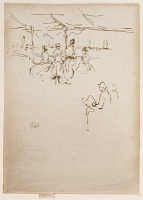The Landing Stage, Cowes | ||
| Number: | 309 | |
| Date: | 1887 | |
| Medium: | etching | |
| Size: | 134 x 96 mm | |
| Signed: | butterfly at left | |
| Inscribed: | no | |
| Set/Publication: | no | |
| No. of States: | 3 | |
| Known impressions: | 15 | |
| Catalogues: | K.328; M.322; W.245 | |
| Impressions taken from this plate (15) | ||
KEYWORD
awning, balcony, jubilee, naval review, man seated, people, pier, sailing ship, sea, ship, steamer, woman standing.
TITLE
Several different titles have been given to this etching, as follows:
'Landing Stage Cowes' (1887, Whistler). 1
'Ryde Pier' (1899, Frederick Wedmore (1844-1921)). 2
'Naval Review The Landing Stage. Cowes' (1903/1935, possibly Rosalind Birnie Philip (1873-1958)). 3
'Landing-Stage, Cowes' (1909, Howard Mansfield (1849-1938)). 4
'The Landing Stage, Cowes' is the preferred title, based on Whistler's original title with added punctuation.
'Landing Stage Cowes' (1887, Whistler). 1
'Ryde Pier' (1899, Frederick Wedmore (1844-1921)). 2
'Naval Review The Landing Stage. Cowes' (1903/1935, possibly Rosalind Birnie Philip (1873-1958)). 3
'Landing-Stage, Cowes' (1909, Howard Mansfield (1849-1938)). 4
'The Landing Stage, Cowes' is the preferred title, based on Whistler's original title with added punctuation.
1: [18-23 August 1887] , GUW #13234.
2: Wedmore 1899 (cat. no. 245).
3: Envelope containing copper plate, Hunterian Art Gallery.
4: Mansfield 1909 (cat. no. 322).
DESCRIPTION
An awning with a wavy edge shades people on the pier. In the foreground a man sits reading a newspaper. Behind him are three ladies and a girl (the women at each side are seated) watching sailing ships in the bay and, to left, a small steam-boat. The women are wearing bonnets and narrow-waisted jackets with puffed sleeves over skirts gathered at the back into small bustles.
SITE
Both Ryde and Cowes are on the Isle of Wight, off the south coast of England. Fountain Pier at Cowes was built around 1840 and removed about 1893.
On the day of the Naval Review, Queen Victoria (1819-1901) was staying at Osborne on the Isle of Wight. The Royal yacht Victoria and Albert sailed from Cowes to review the fleet, while the troopships containing visitors left from Portsmouth and Southampton. 5
5: 'The Naval Review', The Times, 23 July 1887, p. 12.
DISCUSSION
Au bord de la mer [m1027] is a comparable composition involving figures framed by awnings; it could be said to derive from early compositions such as Variations in Flesh Colour and Green: The Balcony [y056].
